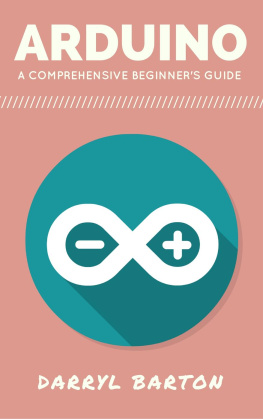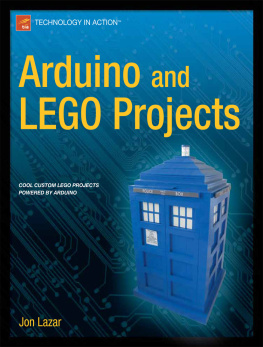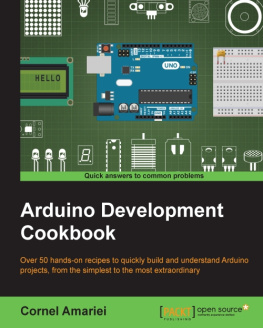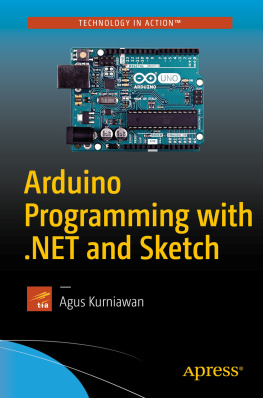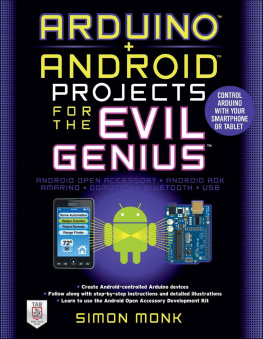Arduino For Beginners
How to get started with your arduino, including Arduinobasics, Arduino tips and tricks, Arduino projects and more!
Introduction
I want to thank you and congratulate you for downloading the book,ArduinoFor Beginners - How to get started with your arduino, including Arduinobasics, Arduino tips and tricks, Arduino projects and more!.
This book contains proven steps and strategies on how to use Arduino in yourtech projects.
Arduino became a popular solution that extends computing and robotics toindividuals outside technology field. Hobbyists can do these projects at homewhile gaining all the advantages this product offers.
This book will teach you all about Arduino and the working components behindits functions. As a beginner, this book teaches you of the concepts, importantArduino parts, basic coding fundamentals and many more.
Towards the end of the book, youll find several tips and tricks, as well asbeginner-level project ideas that will help you master Arduino!
Thanks again for downloading this book. I hope you enjoy it!
Copyright 2014 All rights reserved.This document is geared towards providing exact and reliable information inregards to the topic and issue covered. The publication is sold with the idea thatthepublisherisnotrequiredtorenderotherwise,qualifiedservices.Ifadviceisaccounting,
necessary,officiallypermitted,orlegalorprofessional,a
practiced individual in the profession should be ordered.
- From a Declaration of Principles which was accepted and approved equally by aCommittee of the American Bar Association and a Committee of Publishers andAssociations.
In no wayisit legal to reproduce,duplicate, or transmitany part of thisdocument in either electronic means or in printed format. Recording of thispublication is strictly prohibited and any storage of this document is not allowedunless with written permission from the publisher. All rights reserved.
The information provided herein is stated to be truthful and consistent, in thatany liability, in terms of inattention or otherwise, by any usage or abuse of anypolicies,processes, ordirectionscontainedwithinisthesolitaryandutterresponsibility of the recipient reader. Under no circumstances will any legalresponsibilityorblamebeheldagainstthepublisherforanyreparation,damages, or monetary loss due to the information herein, either directly orindirectly.
Respective authors own all copyrights not held by the publisher.
The information hereinis offered for informational purposes solely, and isuniversal as so. The presentation of the information is without contract or anytype of guarantee assurance.
The trademarks that are used are without any consent, and the publication of thetrademarkiswithoutpermissionorbackingbythetrademarkowner.Alltrademarks and brands within this book are for clarifying purposes only and arethe owned by the owners themselves, not affiliated with this document.
Table of Contents
Chapter 1. Arduino Basics: Knowing Arduino
Theamazingworldcomputingkeptonstirringthemindsofindividualsinterested in this field. They want to get their hands into technological projectsusing a simple circuit board and program codes. Arduino makes it possible forpeopleoutsidetechnologyfieldtocreatetheirowndeviceswithspecificfunctions.
In this section, youll learn about:
- Arduino and its definition
- Where its used
- Available Arduino types
- Arduinos limitations
DefinitionArduino is a microcontroller developed as an open-source system. Its poweredby a chip and composed of different components soldered on the board. Itresembles a mini motherboard used in an array of projects.
Arduino is also programmable according to the required functions in a project.Programs will be used to assign certain pins to execute specific tasks. Parts andpins are identified using the labels printed on the board. Youll more about partsand in Chapter 3.
The termArduino is often referred to the actual mini board. However, Arduinoboard needs to use its software version, also known as Arduino software. Its usedfor programming commands that indicate the boards purpose or function. Moredetails about Arduino program will be discussed on Chapter 3.
The Advantage of Using Arduino Many people appreciated this product as its designed to make robotics and mini
computing accessible to regular users. Arduinois marketed for prototypinghobbyists, novice engineers, and those who want to try simple robotics despitethe lack of engineering expertise. Everyone who wants to explore robotics andcomputing can now do projects right at their homes.
Another advantage is its inexpensive price. An Andruino boards price starts at
$20 and up depending on the number of installed parts, part types, and slots. Theprice alone is suitable for beginners who are technically testing Arduino-poweredrobotics and computing. Hobbyists can complete small projects, which dontusually cost a lot of money, but still offers the features required by developers.
Arduinos open-source and programmable platform brings another benefit. Beingan open-source system, Arduino can perform functions required by developers byuploading source codes to get their projects going.
Long-term advantage is using Arduino can help hobbyists build their own boards.UserslearnArduinosarchitecturebyusingtheboardandtheirfunctions.Developers can then personalize their future boards according to their projectscomplex system.
Finally, Arduino works with different components, allowing designers to be moreplayful with their project ideas. Projects can be as simple as activating blinkingLEDs or blinking or projects that are more mechanical in nature.
What Projects can You Do with Ardruino?Arduinoisacompletedevicethatletsdevelopersdovirtuallyanyproject.Common and simple projects include developing a small computer for cars, socialmedialike counters, MIDI controllers, and a lot more. People who are moreambitious can build small robots, given that the right board is used. Dependingon the design and functionalities, a mini robot project may require complicateddevelopment.
This board is capable of supporting all these projects through its components,which youll learn in Chapter 3.
LimitationsAlthough this system allows hobbyists to do almost everything, Arduino still hasits limitations. Its inability to capture and record videos is its main downside. Theboards specs are insufficient to support these tasks, which is very different from
typical computers and portable devices. These devices are meant for mediarecording and designed with appropriate components.
However,Arduinoiscapableofprojectingimagesorgraphicsthroughanexternal display. Unlike capturing videos, projecting wont use as much resourcesand storage from the board. Also, utilizing an exterior display will handle dataconversion to display images or other information. Developers must create aspecial configuration to make this setup possible.
Available TypesArduino comes in different models and types. Each model possesses uniquefeatures and matches a specific function. As of now, Arduino is distributed inthree models. Certain models are available in several variants that cater to specialprojects requirements.
Important Things to Remember Several reminders in using Arduino in your project:
Get the Right Arduino According to Project RequirementsArduino has different pin numbers and parts depending on the model. Gettingthe wrong model will result to system incompatibility. Some pins may not workproperly when used in other boards.
Another issue is using the wrong board can be confusing for the developer.Project guides specify pin numbers and parts. Being a novice Arduino user, youmight get confused when you dont find jumpers, pin numbers, and other vitalparts for the project.


